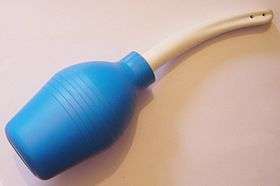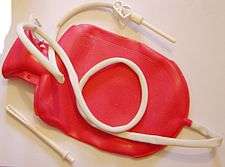Douche
A douche is a device used to introduce a stream of water into the body for medical or hygienic reasons, or the stream of water itself. Douche usually refers to vaginal irrigation, the rinsing of the vagina, but it can also refer to the rinsing of any body cavity. A douche bag is a piece of equipment for douching—a bag for holding the fluid used in douching. To avoid transferring intestinal bacteria into the vagina, the same bag must not be used for an enema and a vaginal douche.
| Douche | |
|---|---|
 A vaginal bulb syringe with lateral holes near the tip of the nozzle | |
| Pronunciation | /duːʃ/ |
| ICD-9-CM | 96.44 |
| MeSH | D044364 |
Douching after sexual intercourse is not an effective form of birth control.[1] Additionally, douching is associated with a number of health problems, including cervical cancer, pelvic inflammatory disease, endometritis, and increased risk of sexually transmitted infections. Thus, its use is not recommended.[2]
Etymology
The word's first known use is in 1766. Douche came into English via French, from Italian: doccia "conduit pipe" and docciare "pour by drops" to douche, from doccia water pipe, probably back-formation from doccione conduit, from Latin: duction-, ductio means of conveying water, from ducere to lead.[3] In French today it means shower, as it does in many non-English European languages.
Overview

Vaginal douches may consist of water, water mixed with vinegar, or even antiseptic chemicals. Douching has been touted as having a number of supposed but unproven benefits. In addition to promising to clean the vagina of unwanted odors, it can also be used by women who wish to avoid smearing a sexual partner's penis with menstrual blood while having sexual intercourse during menstruation. In the past, douching was also used after intercourse as a method of birth control, though it is not effective (see below).
Many health-care professionals state that douching is dangerous, as it interferes with both the vagina's normal self-cleaning and with the natural bacterial culture of the vagina, and it might spread or introduce infections. Douching is implicated in a wide variety of dangers, including: adverse pregnancy outcomes including ectopic pregnancy, low birth weight, preterm labor, preterm birth, and chorioamnionitis; serious gynecologic outcomes, including increased risk of cervical cancer, pelvic inflammatory disease, endometritis, and increased risk for sexually transmitted infections, including HIV; it also predisposes women to develop bacterial vaginosis (BV),[4] which is further associated with adverse pregnancy outcomes and increased risk of sexually transmitted infections.[5] Due to this, the U.S. Department of Health and Human Services strongly discourages douching, citing the risks of irritation, bacterial vaginosis, and pelvic inflammatory disease (PID). Frequent douching with water may result in an imbalance of the pH of the vagina, and thus may put women at risk for possible vaginal infections, especially yeast infections.[6]
In May 2003, a randomized, controlled, multi-center study was conducted with 1827 women ages 18–44 who were regular users of a douche product and who had been treated recently for a sexually transmitted bacterial infection or bacterial vaginosis. Women were randomly assigned to use either a newly designed and marketed douche product or a soft cloth towelette. There was little or no indication of a greater risk of PID among women assigned to use the douche product (versus soft cloth towelette).[7]

Antiseptics used during douching disturb the natural balance of bacteria in the vagina and can cause infections.[8] Unclean douching equipment may introduce foreign bodies into the vagina. Douching may also wash bacteria into the uterus and Fallopian tubes, causing fertility problems.[9] For these reasons, the practice of douching is now strongly discouraged except when ordered by a physician for medical reasons.[8]
Douching after intercourse is estimated to reduce the chances of conception by only about 30%.[10] In comparison, proper male condom use reduces the chance of conception by as much as 98%.[11] In some cases douching may force the ejaculate further into the vagina, increasing the chance of pregnancy. A review of studies by researchers at the University of Rochester Medical Center (N.Y.) showed that women who douched regularly and later became pregnant had higher rates of ectopic pregnancy, infections, and low birth weight infants than women who only douched occasionally or who never douched.[8]
A 1995 survey quoted in the University of Rochester study found that 27% of U.S. women age 15 to 44 douched regularly, but that douching was more common among African-American women (over 50%) than among white women (21%),[8] and frequent douching contributes to more frequent bacterial vaginosis among African-American women than the average.[4]
Medical doctor Harriet Hall writes that not only can douching change the pH of the vagina and lead to infections, "There is no need ... to cleanse the vagina. It cleanses itself".[12]
Slang uses
Douchebag and its variants, or simply douche,[13][14] are pejorative terms[14] referring to an arrogant, obnoxious, or despicable person.[15] The slang usage of the term originated in the 1960s.[16]
See also
References
- Rengel, Marian (2000). Encyclopedia of birth control. Phoenix, Ariz: Oryx Press. p. 65. ISBN 9781573562553.
- Cottrell, BH (Mar–Apr 2010). "An updated review of evidence to discourage douching". MCN: The American Journal of Maternal/Child Nursing. 35 (2): 102–7, quiz 108–9. doi:10.1097/NMC.0b013e3181cae9da. PMID 20215951.
- "Douche – Definition and More from the Free Merriam-Webster Dictionary". Merriam-webster.com. 2012-08-31. Retrieved 2013-08-03.
- Velasquez-Manoff, Moises (Jan 11, 2013). "What's in Your Vagina? A healthy microbiome, hopefully". Slate.
- Cottrell, B. H. (2010). "An Updated Review of Evidence to Discourage Douching". MCN: The American Journal of Maternal/Child Nursing. 35 (2): 102–107, quiz 107–9. doi:10.1097/NMC.0b013e3181cae9da. PMID 20215951.
- "WebMD article on the causes of yeast infections, including douching". Women.webmd.com. 2011-10-31. Retrieved 2013-08-03.
- Rothman KJ, Funch DP, Alfredson T, Brady J, Dreyer NA (May 2003). "Randomized field trial of vaginal douching, pelvic inflammatory disease and pregnancy". Epidemiology. 14 (3): 340–8. doi:10.1097/00001648-200305000-00015. PMID 12859036.
- Seppa, N. (2 January 1999). "Douching associated with pregnancy risk" (PDF). Science News. 155 (1): 7. doi:10.2307/4011204. JSTOR 4011204. Archived from the original (PDF) on September 26, 2012. Retrieved 1 March 2013.
- "Warning from Kelly Shanahan, MD on douching". Health.ivillage.com. Archived from the original on 2007-11-11. Retrieved 2013-08-03.
- Baird, Donna; Weinberg, Clarice (June 1996). Grigg, Bill (ed.). "NIH Study: Among Women Who Want to Get Pregnant, Douching May Delay Conception". American Journal of Public Health. Retrieved 2019-07-12 – via NIH.
- Trussell J (2011). "Contraceptive Efficacy." (PDF). In Hatcher RA, Trussell J, Nelson AL, Cates W, Kowal D, Policar M (eds.). Contraceptive Technology (Twentieth Revised ed.). New York NY: Ardent Media.
- Hall, Harriet (2018). "The Care and Feeding of the Vagina". Skeptical Inquirer. 42 (5): 28–29.
- "Define Douche at Dictionary.com". Dictionary.com. Retrieved 24 December 2015.
- "douche – Dictionary Definition". Vocabulary.com. Retrieved 24 December 2015.
- "Define Douchebag at Dictionary.com". Dictionary.com. Retrieved 24 December 2015.
- "Terms of Derogation". Drbilllong.com. Archived from the original on 14 April 2006. Retrieved 2013-08-03.
External links
| Look up douche bag in Wiktionary, the free dictionary. |
- "Douching" Womenshealth.gov (archive from 24 October 2008)
- "Douching fact sheet" at Womenshealth.gov
-solution.jpg)

